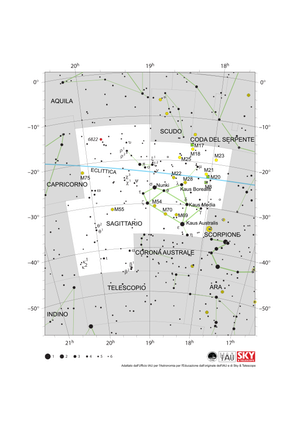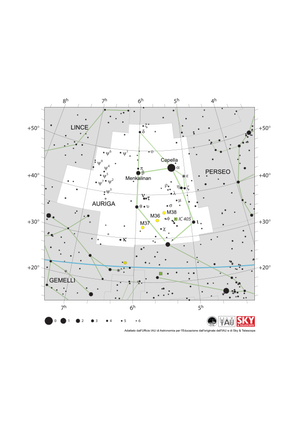Termine del Glossario Nebulosa
Descrizione Una nebulosa è un oggetto celeste lontano che ha l'aspetto di una nube. Di solito, le nebulose sono costituite da gas e polveri interstellari. Storicamente, il termine nebulosa includeva qualsiasi oggetto esteso dall'aspetto sfocato, comprese quelle che oggi riconosciamo come galassie - sistemi stellari distanti come la nostra galassia, la Via Lattea. Oggi il termine nebulosa si limita alle nubi di gas e polvere che fanno parte del mezzo interstellare, ovvero il gas e la polvere tra le stelle di una galassia. La categoria comprende diversi tipi di oggetti: Le nubi molecolari sono relativamente fredde e scure e sono costituite prevalentemente da idrogeno molecolare; all'interno di queste nubi si formano le nuove stelle. Le nubi molecolari giganti possono contenere fino a qualche milione di masse solari di idrogeno gassoso. Le giovani stelle emettono spesso sottili getti di gas ionizzato; quando questi getti eccitano il gas circostante, il risultato è un tipo di nebulosa chiamata oggetto di Herbig-Haro. Quando si sono formate stelle massicce, la loro intensa radiazione fa sì che il gas circostante emetta una caratteristica luce rossastra; ne risultano nebulose di gas idrogeno caldo e ionizzato, chiamate regioni HII. Altri tipi di nebulose sono associati alla morte delle stelle: Le stelle di bassa massa lasciano dietro di sé involucri di gas in espansione, definiti (in modo un pò ambiguo) nebulose planetarie. Quando una stella di grande massa esplode come supernova, il gas espulso forma un tipo di nebulosa definito come resto di supernova.
Termini correlati
Vedi questo termine in altre lingue
status del termine e della definizione La definizione originale di questo termine in inglese é stata approvata da un ricercatore astronomo e da un docente La traduzione di questo termine e della sua definizione sono state approvate da un ricercatore astronomo e da un docente
Il Glossario Multilingue OAE é un progetto dell'Ufficio IAU per la didatticadell'astronomia (OAE) in collaborazione con l'ufficio IAU OAO per la DivulgazioneAstronomica (OAO). I termini e le definizioni sono stater scelte, scritte eriviste da un impegno collettivo da parte di OAE, i Centri e i Nodi OAE e iCoordinatori Nazionali per la Didattica dell'Astronomia e da altri volontari.Potete trovare una lista completa dei crediti, Tutti i termini del glossarioE le definizioni sono pubblicate su Creative Commons CC BY-4.0 licenza e dovrebbero essere accreditate ad IAU OAE.
Se noti un errore di fatto o di traduzione in questo termine del glossario, per favore contattaci.
Diagrami correlati
Mappa della costellazione del Sagittario
Crediti: Adattato dall'Ufficio IAU per l'Astronomia per l'Educazione dall'originale di IAU/Sky & Telescope
License: CC-BY-4.0 Creative Commons Attribuzione 4.0 Internazionale (CC BY 4.0) icone
Mappa della costellazione dell'Auriga
Crediti: Adattato dall'Ufficio di Astronomia per l'Educazione della IAU dall'originale della IAU e di Sky & Telescope.
License: CC-BY-4.0 Creative Commons Attribuzione 4.0 Internazionale (CC BY 4.0) icone
Mappa della costellazione di Cefeo
Crediti: Adattato dall'Ufficio di Astronomia per l'Educazione della IAU dall'originale della IAU e di Sky & Telescope.
License: CC-BY-4.0 Creative Commons Attribuzione 4.0 Internazionale (CC BY 4.0) icone
Mappa della Costellazione Carina
Crediti: Adattato dall'Ufficio di Astronomia per l'Educazione della IAU dall'originale della IAU e di Sky & Telescope.
License: CC-BY-4.0 Creative Commons Attribuzione 4.0 Internazionale (CC BY 4.0) icone
Mappa della Costellazione del Cigno
Crediti: Adattato dall'Ufficio di Astronomia per l'Educazione della IAU dall'originale della IAU e di Sky & Telescope.
License: CC-BY-4.0 Creative Commons Attribuzione 4.0 Internazionale (CC BY 4.0) icone
Attività correlate
Reading the Rainbow
astroEDU educational activity (links to astroEDU website) Description: By understanding how rainbows work, you can discover about light and its properties, learning about stars, nebulae, galaxies, and our Universe.
License: CC-BY-4.0 Creative Commons Attribuzione 4.0 Internazionale (CC BY 4.0) icone
Fasce d'età
14-16
, 16-19
, 19+
Livello di istruzione
Informal
, Middle School
, Secondary
, University
Aree di apprendimento
Interactive Lecture
, Observation based
, Social Research
Costi:
Low Cost
Durata:
1 hour 30 mins
Dimensione del Gruppo:
Group
Abilità:
Analysing and interpreting data
, Asking questions
, Engaging in argument from evidence














